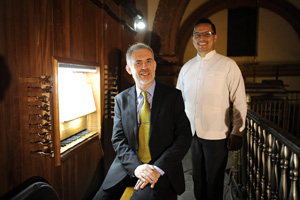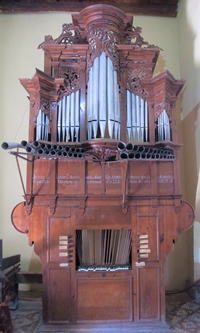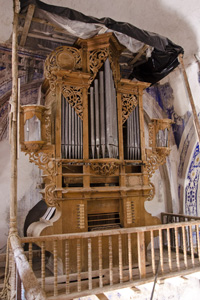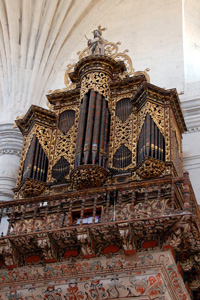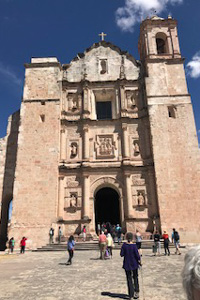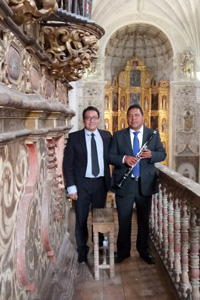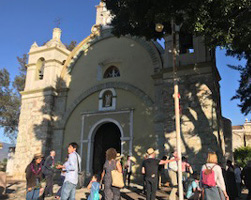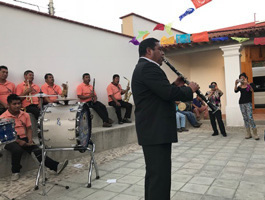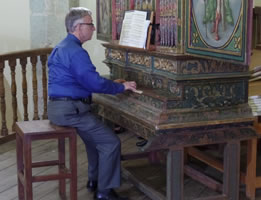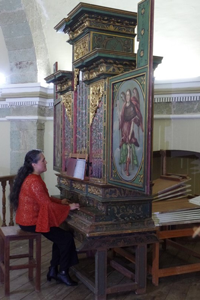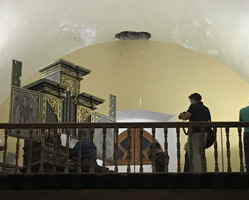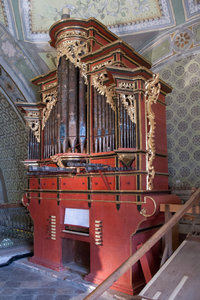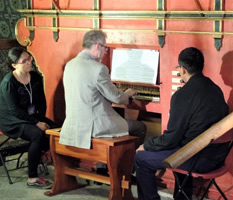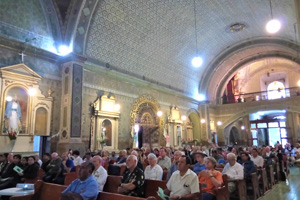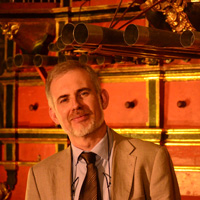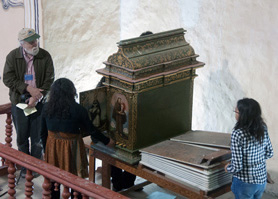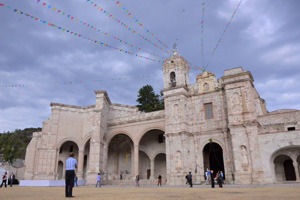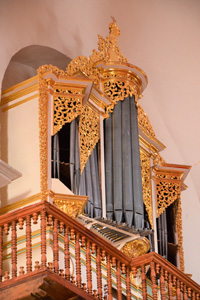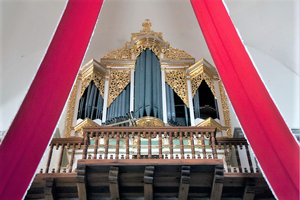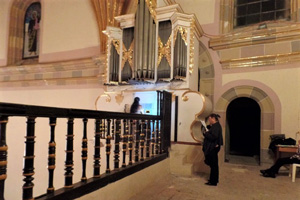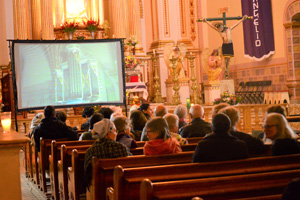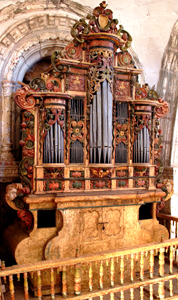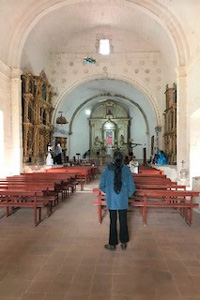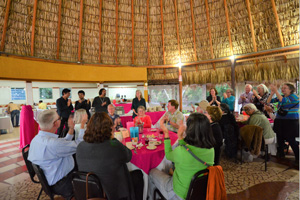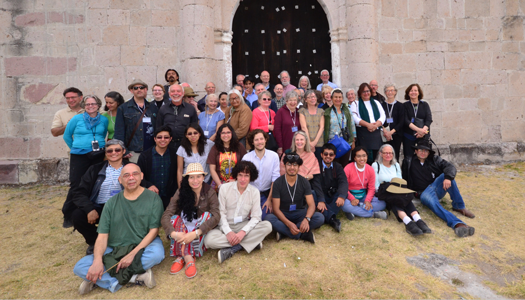 |
TWELFTH INTERNATIONAL
|
Each IOHIO Festival builds on the success of its predecessors, making this one the best ever. It was also the most extensive, since the restored organ in Jalatlaco could be included in the concert programming. February 14 (Wednesday) Around 20 organists and organ students met in the San Matías Jalatlaco church for the first event of the festival, a talk by Andres Cea Galán, president of the “Instituto del Órgano Hispano” about “Spanish music: Organs and organists during the 16th -18th centuries. That evening Cicely Winter and Valentín Hernandez presented the First Concert of the Festival of Oaxacan folk music (program) transcribed for organ and percussion in the Basilica de la Soledad. This program always serves as an introduction for the events to come, and people sang along exuberantly to some of the best-known Oaxacan regional songs. This and all succeeding concerts were projected onto a screen in the church, so that the audience could have a better view of the artists and see the action in the choir loft, particularly how pulling the stops changed the organ’s sound. The magnificent decorated case of this monumental 8´ (eight foot) organ bears the earliest date of any Oaxacan organ: 1686. It was restored in 2000 and is played regularly in the mass. February 15 (Thursday) Registration took place throughout the day in the Oaxaca Philatelic Museum (MUFI), giving us a chance to finally meet the people we had been corresponding with and greet old friends from past festivals. The Inauguration of the Festival that afternoon began with a presentation by Cicely Winter, director of the IOHIO, about the activities and goals of the festival. Joel Vásquez, project coordinator of the IOHIO, spoke about our teaching project and our success in having the mass played every Sunday in five Oaxacan churches by our students or by him. In addition, it is most gratifying that people increasingly request that their private masses for baptisms, 15th birthday, weddings, etc. be accompanied by the pipe organs rather than an electronic organ or keyboard. We were honored by the presence of Ignacio Toscano, Secretary of Culture for the State of Oaxaca, and Omar Vásquez, Director of the Oaxaca Regional Center of the Instituto Nacional de Antropología e Historia (INAH), who commented on the shared goals of their respective institutions and the IOHIO and offered their congratulations for the festival. Cicely also expressed special appreciation to Alfredo Harp Helú for his indispensable support of seven organ restoration projects in Oaxaca over the past twenty years, including most recently the organs in Tlacolula and Jalatlaco. After the welcoming reception, we walked a few blocks to the church of San Matías Jalatlaco. The Second Concert of the Festival was presented by the renowned Dutch organist Jan Willem Jansen. His program had a theme “The apple doesn’t fall far from the tree” and included father and son pairs: Alessando and Domenico Scarlatti, and Johann Sebastian Bach and three of his sons. (program) The last piece “Ah, vous dirai-je Maman,” familiar to everyone as the theme of “Twinkle twinkle little star,” elicited a chuckle of recognition from the audience. The mainly 18th century repertoire was perfect for this organ built in 1866. This year marked the festival debut of the Jalatlaco organ as a playable instrument. One of our regular attendees commented on the evolution of this organ during his last three visits: first as an unrestored instrument (2002-2014) when we discussed our hopes for its restoration, then as a restoration in process by the Gerhard Grenzing Company (2016), and finally as a concert instrument (2018). This elegantly proportioned 8´ organ was built by the Oaxacan organbuilder Pedro Nibra and has a 56 note chromatic keyboard and “almost equal” temperament, unlike the other organs heard during the festival with their 45 note keyboards, short octaves, and meantone tuning. It was painted blue around 1880 when Nibra oversaw various modifications to the organ. Afterwards in the atrium of the church under a clear night sky, we enjoyed bread and chocolate offered by our friends from Chocolate Mayordomo and tamales de frijol prepared by Jalatlaco’s favorite tamalera. February 16 (Friday) The day started with a bilingual presentation by Cicely Winter in the Francisco de Burgoa Library within the Santo Domingo Cultural Center about “The Historic Organs of Oaxaca and the Work of the IOHIO”. Although the title of the talk has not changed over the years, the content is updated every year to publicize the advances of our various projects: protection, conservation, restoration, concerts, archive and manuscript discoveries, recordings, teaching, and publications. This was followed by a tour of the splendid church of Santo Domingo de Guzmán, seat of the Dominican order in the Valley of Oaxaca since the 16th century, and the Museum of the Cultures of Oaxaca in the former convent, led by guides Pablo Gonzalez and Gabriel Sanchez.    
Our next stop has always been San Andrés Huayapam, located on the outskirts of Oaxaca City. This year the plan was complicated by the closing of the church after the tragic earthquakes in September 2017. Luckily it was not severely affected, but religious activities have been celebrated under a temporary roof beside the church until the roof damage could be repaired. We did not know if the INAH would grant us access, but fortunately the provisional permission came through just days before the visit.
We were received with a customary drink of tejate, traditionally served in colorful painted half gourds. A local specialty of prehispanic origin, this delicious foamy drink is made with ground cacao, corn meal, the seed of the mamey fruit, and the flower of a tree (rosita de cacao) which grows only in or near Huayapam. This charming church has one of the most beautiful baroque altarpieces in Oaxaca, whose intricately carved golden columns are referred to as “gilded lace”. Also famous is the collection of antique exvotos, petitions usually to the Virgin Mary that are painted on small tin plaques. The 4´ organ (1772), large for a table organ, is nearly intact with its original keyboard and pipes. It is simply carved, a style we refer to as a “country organ”, and was probably originally unpainted, then painted bright red, still seen backing the keyboard, and eventually repainted sober maroon in the 20th century. In Huayapam we savored the first of many local meals, this time mole amarillo, in the atrium of the church. During the free time between the Huayapam comida and the evening concert, some went to see the famous tree in Santa María del Tule, while visiting organists and students had a chance to play a meantone tracker organ with divided registers in the Oaxaca Cathedral.
February 17 (Saturday)
This year more than 100 people participated in our popular all-day excursion to the Mixteca Alta. We crossed a river to arrive at the little stone church in Santa María Tinú and it seemed as though the entire adult population of the town, now reduced to 152 people, was there to greet us. The authorities welcomed us with great ceremony at the entrance of the church, their canes (bastones) of office in hand. During our reconnaissance visit some weeks before, we had suggested that the local women display their handicrafts, which in the Mixteca region means palm weaving (hats, baskets, sleeping mats). But palm has given way to colorful raffia and what a sight greeted us! Multicolored woven baskets hung from the trees and lined up atop the walls of the atrium, while the stone cross in the atrium was decorated cucharillas, the white base of maguey leaves. Nearly everyone bought something from the women as we sipped sweet atole.
The Tinú church houses a disproportionately large organ. The date of construction, 1828, and the name of the organ builder, are written inside the case….such luck! Perhaps the organ was originally commissioned for a larger church, then sold to Tinú, or the community simply wanted something grand. The organ, completely intact and played 50 years ago, still grunts and wheezes when one of the bellows located in the loft above is pumped. Unfortunately because of the reduced population and remote location of the town, a restoration would not be practical. Our next stop was in the lovely baroque church of San Andrés Sinaxtla. The case of the organ built in 1791 combines both baroque and neo-classic case design elements. The construction is idiosyncratic, since it’s the only instrument of this size with direct suspended tracker action, i.e., no roller board. Of particular interest is the inscription across the façade including the name of the donor, the date of construction, and the cost of the organ, but typically omitting the name of the organbuilder. Just down the road from Sinaxtla sitting on a promontory overlooking the Yanhuitlán Valley is the church of San Mateo Yucucuí (population 142). This organ built in 1743 is the least altered of all the 8´ 18th century Oaxacan organs and when last played (1930s?), it is said that its sound could be heard for miles around. The organ was never painted or gilded like its counterpart in Teotongo, probably not by choice during that opulent baroque era, but rather because of the cost. It is richly carved and largely intact and it’s tempting to imagine the pipes and mechanism of the Yucucuí organ inserted into the stunning Teotongo case to make one amazing organ! The floor of the high balcony on which the organ sits is much deteriorated and access to the façade is dangerous, so our efforts to clean and document the organ have been restricted. The Fourth Concert of the Festival took place in Santo Domingo Yanhuitlán, (program) the 16th century Dominican stronghold in the Mixteca Alta region. With its soaring stone vault supported by lateral flying buttresses and its magnificent altarpieces, it is one of Mexico’s most majestic complexes of baroque art. Organist David Soteno and clarinetist Lorenzo Meza, both from near Mexico City, thrilled the audience with a program that reverberated throughout the immense nave. This magnificent organ, located on a side balcony, was built around 1690-1700 and restored/rebuilt in France in 1998. Its case is one of the most elaborately decorated of all Mexican organs, with Dominican symbols and fantastic swirling imagery, similar to the Soledad organ case, and fierce faces on the façade pipes. Because of earthquake damage to the main altarpiece (retablo), we could sit only in the front half of the church. The day culminated with the traditional pre-concert festivities in San Andrés Zautla. We were received in the atrium of the church by the local band with fireworks, plenty of mezcal, necklaces of bugambilia, dancing, and finally a delicious meal of estofado de pollo (chicken stewed in almond sauce) served in the municipal library across the street from the church.
After dinner, we crowded into the church where many people from the community were already waiting for the Fifth Concert of the Festival. This was the first of three collective concerts, whose goal has been to offer the opportunity to play the organs to as many organists and students as possible. Roberto Ramirez, Andre Lash, Andres Cea, Willem Jansen, Laura Carrasco, Christoph Hammer presented wonderfully contrasting pieces to top off such a busy and exciting day. (program) We were honored to have with us José Miguel Quintana from Mexico City whose association “Órganos Históricos de México” had financed the restoration of the Zautla organ in 1996. The case of this 4´ table organ (1726) is exquisitely carved and gilded and painted with images of saints and archangels. A motor was installed in 2017 by Oaxacan organbuilder David Antonio Reyes and the organ moved to the other side of the loft away from the stairway. No longer do we have to worry about those startling moments of silence when the bellows pumpers were distracted and lost their rhythm. The registers of table organs are controlled by tabs protruding from the sides of the case and thanks to the screen projection, the audience could appreciate the teamwork involved. Joel and David had to make a detachable music rack to prevent the pages resting against the façade pipes from being blown away. Clearly the organists of past centuries played by memory or improvised, and the position of the keyboard indicates that they stood to play. Thanks to the ongoing support of the Federal Road and Bridge Commission (CAPUFE), a special entrance was opened from the super highway, allowing us direct access to and from Zautla. February 18 (Sunday) Jan Willem Jansen presented the Sixth Concert of the Festival in San Jerónimo Tlacochahuaya entitled “Four European Countries”, featuring repertoire from Italy, Holland, Germany, and Spain. (program) In February 2017 the organ was cleaned, tuned, and voiced by an expert from the Grenzing Company and was in perfect condition until the September 7 earthquake jiggled the pipes. Luckily organbuilder Hal Gober was on hand to make the necessary adjustments. The church is one of the loveliest in Mexico with its exuberant interior floral decoration and splendid baroque altarpieces, all restored in the past 20 years. The 4´ organ was built sometime before 1735 and restored in 1991. The case and pipes are decorated with floral motifs, and the organ harmonizes beautifully, both visually and acoustically, with the architecture of the church.  


After a buffet lunch of Oaxacan specialties in the “Donají” Restaurant in Mitla, we ventured on to the small baroque church in San Miguel del Valle at the foothills of the Sierra Juarez with painted ceramic bowls imbedded into the bell towers. The 4´ table organ is unfortunately in poor condition, more typical than not of the unrestored instruments and not such a bad thing for our participants to see. The case is painted blue with neo-classic decoration; it has only four registers and no accessory (toy) stops. It seems to date from around 1800, making it the last of the Oaxacan table organs. An added attraction of this Zapotec-speaking community are the elaborately embroidered aprons and once again we were able to support women’s handicrafts with our purchases.  
 
Our friends from “Chocolate Mayordomo” received us with bread and chocolate upon arrival in Santa María de la Asunción Tlacolula. We admired the little 2’ organ which appears to date from around 1700 as indicated by the style of its remaining painted decoration. Originally located in the choir loft of the baroque side chapel, it is the smallest Oaxacan organ and has only two registers. Those who needed a break from churches could roam around one of the most famous indigenous markets in Oaxaca and admire the women’s costumes and the stalls piled high with local produce. The Seventh Concert of the Festival was presented by Andrés Cea Galán featuring 16th and 17th century repertoire which highlighted the beautiful sound of this organ. (program) It was built in Oaxaca in 1792 by Manuel Neri y Carmona, restored by the Gerhard Grenzing Company, and inaugurated during the Tenth IOHIO Festival in 2014. The visual impression of the baroque style case, painted red and black and opulently gilded, is striking, and it has the most elaborately painted façade pipes in all of Mexico. Local people began to arrive for the mass following the concert, so by the end the church was packed. It’s likely that many were hearing and viewing the organ (on the screen) for the first time and they must have been amazed by the rich, full sound of the organ. February 19 (Monday) Our two-day excursion to the Mixteca Alta began with a stop in Santa María de la Natividad Tamazulapan where we heard Eighth Concert of the Festival. This second collective concert was presented by organ students Greta Baltazar, Alejandro Lemus, Mario Moya, and Zeltzin Perez, who study in university programs in Mexico City, along with Joel Vasquez from the IOHIO. (program) Arnoldo Perez, a young organ builder in process, pumped the bellows. This church had been closed after the second September earthquake, which particularly affected the Mixteca region. Ongoing negotiations with the priest and the INAH allowed us access to the first half of the church and the organ balcony where fortunately no plaster had fallen from the ceiling. The 2´ table organ dating from approximately 1720-1730 is situated in a high balcony overlooking the soaring nave of the church and is exquisitely decorated with images of saints and angel musicians. The case and bellows are original but the pipes, keyboard, and interior components were reconstructed in 1996. The church has one of the most magnificent baroque altarpieces in all Mexico and includes paintings by the renowned 16th century Spanish painter Andrés de Concha. The second organ in this church, an imposing 8´ instrument, faces the small organ from the left balcony. Built in Oaxaca in 1840 by a member of the renowned Martinez Bonavides organbuilding family, it was once a magnificent instrument and is largely intact except for the loss of nearly all its pipes; only the five largest remain in the façade. We then proceeded to the neighboring church of Santiago Teotongo, rich enough in 18th c. baroque art to stand as a museum in its own right. The magnificent case of this 8´ organ, though empty, is integrated stylistically with the opulent altarpieces, and statues of angels once stood atop its towers, singing through their O-shaped mouths via pipes passing through their bodies. The organ was stripped of its pipes, keyboard, and more during the Mexican Revolution and its date is unknown, but the organ’s profile closely resembles that of San Mateo Yucucuí (1743). An added attraction was the 18th century painted armoire in the sacristry, decorated with period figures engaged in their daily activities. The tour continued with a visit to the 16th century church of Santiago Tejupan which could also stand as a museum of colonial religious art in this culturally rich area of the Mixteca Alta. The luxuriously painted organ case (1776) is the last Oaxacan organ with religious imagery. Portraits of the donor and his wife being blessed by his patron saint, Saint Nicholas, are depicted on one side and Santiago on horseback on the other, both unfortunately obscured by layers of grime. Another special feature is the information painted on two decorative medallions on the façade which include the name of the donor, the cost of the organ, and the date of construction, although as in Sinaxtla, omitting the name of the organ builder. Afterward we were treated to a talk about the Mixtec ball game (pelota mixteca). 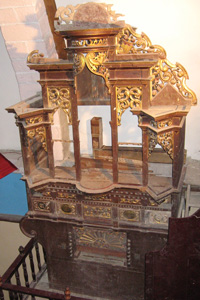 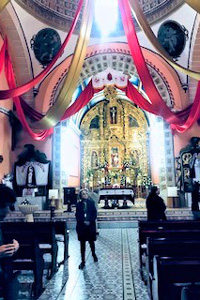
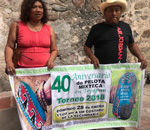 
After lunch in our favorite restaurant “Eunice”, we walked over to the Dominican architectural complex of San Pedro y San Pablo Teposcolula with its church dwarfed by the enormous 16th century open chapel and atrium. The 8´ organ (ca. 1730-1740) has a similar profile to that of Yanhuitlán. The case was painted white with light green touches sometime after the original construction and with its delicate carvings, had a graceful look. However, now we refer to it as the King Midas organ, because in 2010 a well-connected architect took the liberty of gilding at great cost all the decorative carvings and moldings, even though it had only been minimally gilded historically and in fact the organ’s overall manufacture is not of the highest quality.
We drove up through the pine forest to Santa María Tlaxiaco. The imposing “fortress church” was the Dominican outpost for this strategic area of the high sierra in the 16th century. For the final Ninth Concert of the Festival, Ricardo Ramírez, Laura Carrasco Curintzita, Andrés Cea Galán, Michael Barone, Jan Willem Jansen, and David Furniss offered an eclectic program to close the concert cycle. This monumental 8´ instrument, built around 1800 and restored in 2000, is decorated with typical neo-classic design elements, painted white and richly gilded; it synchronizes with the altarpieces of the church, all in homogeneous neo-classic style. We spent the night in the Hotel del Portal on the main plaza and had a chance to wander around the market.
February 20 (Tuesday) Participants divided into two groups. Many chose to visit the late pre-classic and classic (400 BC – 800 AD) Mixtec archeological site and the community museum of San Martín Huamelulpan with Marcus Winter of the INAH. Most of the organists and students opted to stay behind to play the Tlaxiaco organ and had great fun trying out their pieces and helping each other with the registers. Both groups met up in Huamelulpan, then proceeded to the village of San Pedro Mártir Yucuxaco where we were once again formally received by the municipal authorities. The organ here (1740) is complete and in excellent condition, missing only its bellows. It is the least altered of the Oaxacan 4´ table organs, parallel to Yucucui for the 8´ stationary group, and closely resembles the organ in Zautla, although without the painted decoration. The carved pipeshades show two faces in profile, a unique decorative detail, and the keyboard is exquisite.  
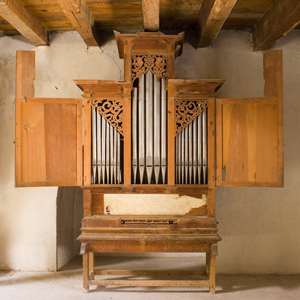 
Our final church and organ visit was in Santa María Tiltepec, for some the crowning visual experience of the field trips. Located in the Dominican sphere of Yanhuitlan and built atop a prehispanic temple, this 16th century church has long been appreciated by art historians for its richly carved asymmetrical façade and stone interior arches. The unrestored 4´ organ, situated on a side balcony, is one of Oaxaca’s oldest (1703) and often elicits a gasp of astonishment when seen for the first time. Unfortunately nothing is known about its history to explain its idiosyncrasies of construction and decoration, and if it didn’t have the characteristic Oaxacan hips on the sides of the case, we might wonder if it were imported.
We proceeded to the Hacienda Santa Marta in San Sebastian Etla on the outskirts of Oaxaca City for our farewell dinner. A scrumptious buffet awaited us with plenty of mezcal and a guitar duo serenading us with Oaxacan folk songs. Toasts and sentimental reminiscences created a special connection with old and new friends who had shared this unique Oaxaca organ adventure.
February 21 (Wednesday) Around 30 people made the trek up to the archeological site of Monte Albán to enjoy an optional guided three hour tour with Dr. Marcus Winter from the Oaxaca Regional office of the INAH. |
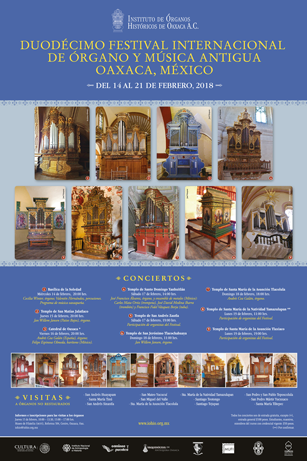















 That night we proceeded to the Oaxaca Cathedral for the Third Concert of the Festival, offered by the eminent Spanish organist and musicologist Andrés Cea Galán with the participation of the Mexican baritone Felipe Espinosa.
That night we proceeded to the Oaxaca Cathedral for the Third Concert of the Festival, offered by the eminent Spanish organist and musicologist Andrés Cea Galán with the participation of the Mexican baritone Felipe Espinosa. 